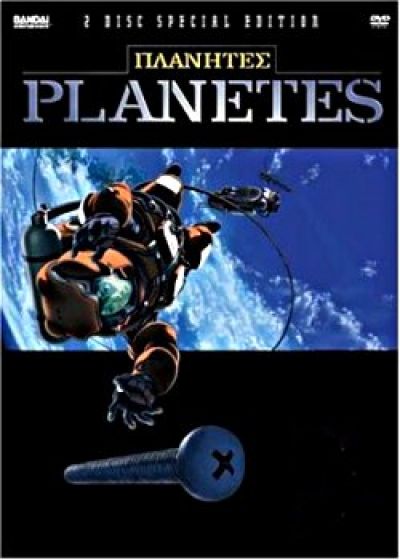Trash Talk
Planetes
By Makoto Yakimura, Gorō Taniguchi & Ichirō Ōkouchi

21 Nov, 2015
0 comments
I love quasi-plausible SF set in our solar system, especially SF that tries to be at least semi-plausible. For a long time, Anglospheric SF had little interest in that particular literary niche. I was forced to look abroad. Which eventually resulted in my exposure to the 2003 – 2004 26-episode anime series Planetes, adapted by Sunrise from Makoto Yakimura’s manga of the same name.
Ah, the bright and shiny world of the 2070s! Space travel is, if not routine, at least common; oil has been replaced by lunar helium three1, thus ensuring the continuation of energy-intensive civilization. Prosperity abounds!
For the people working for Technora’s Half Section, prosperity is unevenly distributed. Space is just where they happen to work. The Half Section, more correctly called the Space Debris Section, are the garbagemen (and women) of SPAAACE!
The more time humans spend in space, the more debris they leave in their wake. Any single piece of debris is potentially a lethal bullet. Unwittingly intersect its orbit and blam! you’re dead … whether you’re a spacesuited worker on EVA, or a passenger in a suborbital rocket. Human industry is now heavily dependent on space resources, so it is utterly vital that space debris be managed effectively.
Idealist Ai Tanabe is stoked to be assigned to the Half Section; she gets to help provide a vital service! All too soon, she finds that necessity does not mean respect. Or even sufficient staffing. Half Section’s nickname comes from the fact that Technora never bothered to fully staff the Debris Section. Overworked, exposed to the dangers of space, the crew of the spacecraft DS12 Toy Box help keep space safe, in return for which they are treated as at best a joke, at worst as pariahs.
But there’s worse to come! The world of Planetes is as starkly divided between rich and poor as the contemporary real world. The International Treaty Organization (INTO) keeps the peace, but only as defined in the interest of the powerful. Many of the people down on Earth will never profit from the riches in space and feel that they have little to lose by lashing out against rich space corporations.
And space stations are particularly vulnerable to terrorism.…
~oOo~
I will leave aside the whole lunar helium three issue1. If you’ve been reading my reviews for any time at all, you have heard that rant. However, I must note some other worldbuilding liberties the creators have taken.
- It makes very little sense to deal with debris by having crewed spacecraft chase the debris down before sending astronauts out on EVA to collect the trash by hand. I understand people want humans in their fiction, but this was just silly.
- The top of the atmosphere does not exhibit a well defined edge. While the characters acknowledge this fact, the plot depends on a boundary below which debris and garbagemen will burn up from friction and above which the debris, and its collectors, are comparatively safe. No boundary, I repeat, no boundary.
- Even granting that space travel is much cheaper in 20752 than now, it seems fairly unlikely that space stations and lunar cities would display the grand vistas and airy galleries depicted in this anime. The greater the surface area, the more radiation shielding is needed. The creators elsewhere acknowledge that radiation is a known danger in space. Space facilities should look more like the offspring of an oil rig and Kowloon Walled City.
Otherwise, the creators do try to play fair. They understand, for example, that their characters are “halfway to anywhere” to quote someone or other, so while most human activity is restricted to the Earth-Moon system, humans have also made forays farther abroad.
In this series, spacefolk are simply a subset of the terrestrial population, not a group that feels itself separate from the Earth. People work in space and some of them die there, but they all have ties to nations and cultures3 down on Earth. This has implications for the over-arching plot that develops over the course of theseries.
The creators also recognize that the Third Industrial Revolution will not necessarily be kind. Few space workers will die of old age. If radiation doesn’t give you terminal cancer, free fall will give you brittle bones, and if that does not kill you, there could easily be a tumbling bolt with your name on it. And if your parents wereinconsiderate enough to give birth to you on the Moon, welcome to life spent in a hospital. Possibly a short life.…
I am reminded of a rant from the obscure British space police procedural StarCops ;
You leave Earth and anything you forget to bring with you will kill you. Anything you do bring with you which doesn’t work properly will kill you. When in doubt, just assume everything will kill you.
But at least the people of Half Section and their worker colleagues can die young knowing they’ve made some spoiled rich bastard down on Earth a bit richer. In the end, isn’t that what really matters?
I don’t believe that this anime is currently available on DVD.
- Augh …
- 2075 is only as distant from us in time as 1955. Huh.
- Some of these postulated future nations appear to have been created with little knowledge of current ecological, political, ethnic, and religious boundaries. This cavalier attitude towards worldbuilding is one thing that Japanese and Anglospheric SF have in common. Alas.
